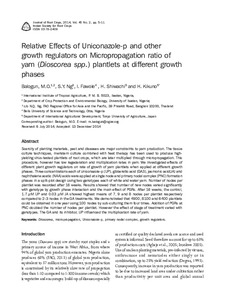| dc.contributor.author | Balogun, M. |
| dc.contributor.author | Ng, S.Y.C. |
| dc.contributor.author | Fawole, I. |
| dc.contributor.author | Shiwachi, H. |
| dc.contributor.author | Kikuno, H. |
| dc.date.accessioned | 2019-12-04T11:03:26Z |
| dc.date.available | 2019-12-04T11:03:26Z |
| dc.date.issued | 2014 |
| dc.identifier.citation | Balogun, M., Ng, S.Y., Fawole, I., Shiwachi, H., & Kikuno, H. (2015). Relative effects of uniconazole-p and other growth regulators on micropropagation ratio of yam (Dioscorea spp.) plantlets at different growth phases. Journal of Root Crops, 40(2), 5-11. |
| dc.identifier.issn | 0378-2409 |
| dc.identifier.uri | https://hdl.handle.net/20.500.12478/1067 |
| dc.description | Open Access Journal |
| dc.description.abstract | Scarcity of seed, pest and diseases are major constraints to yam production. Tissue culture techniques of meristem culture combined with heat therapy have been used to produce high-yielding virus-tested plantlets of root crops, which are later multiplied through micropropagation. However, the micropropagation rate is low in yam. We investigated in vitro, the rate of production of new nodes at some Plant growth regulator regimes applied at specific growth phases of yam. Three concentrations each of uniconazole-p (UP), gibberellic, jasmonic (JA) and naphthalene acetic (NAA) acids were applied at single node and primary nodal complex (PNC) formation phases in a split-plot design using two genotypes each of white and water yams. Number of nodes per plantlet was recorded after 16 weeks. The number of new nodes varied significantly with genotype by growth phase interaction and the main effect of PGRs. After 16 weeks, the control, 1.7µM UP and 0.03µM JA had highest means of 7, 9 and 8 nodes per plantlet compared to 2-3 nodes in the GA treatments. Thus, 4,900, 8,100 and 6,400 plantlets can be obtained in I year from a 100-node plant. In D. alata genotypes, addition of PGRs at PNC doubled the number of nodes per plantlet relative to addition at single node stage, while the effect of stage varied with genotype in D. rotundata. There is an important role for GA and its inhibitor-UP on the rate of yam micropropagation. Optimum multiplication rates can be achieved if the right PGR is applied at a standardized growth phase of a particular genotype. Earliness of genotypes seems to be a major factor that will determine the timing of application of PGRs. |
| dc.language.iso | en |
| dc.subject | Dioscorea |
| dc.subject | Micropropagation |
| dc.subject | Plantlets |
| dc.subject | Gibberellic Acid |
| dc.subject | Jasmonic Acid |
| dc.subject | Uniconazole |
| dc.subject | Naphthaleneacetic Aciddioscorea |
| dc.subject | Micropropagation |
| dc.subject | Plantlets |
| dc.subject | Gibberellic Acid |
| dc.subject | Jasmonic Acid |
| dc.subject | Uniconazole |
| dc.subject | Naphthaleneacetic Aciddioscorea |
| dc.subject | Micropropagation |
| dc.subject | Plantlets |
| dc.subject | Gibberellic Acid |
| dc.subject | Jasmonic Acid |
| dc.subject | Uniconazole |
| dc.subject | Naphthaleneacetic Acid |
| dc.title | Relative effects of Uniconazole p and other growth regulators on micropropagation ratio of yam (Dioscorea spp.) plantlets at different growth phases |
| dc.type | Journal Article |
| dc.description.version | Peer Review |
| cg.contributor.affiliation | International Institute of Tropical Agriculture |
| cg.contributor.affiliation | University of Ibada |
| cg.contributor.affiliation | Food and Agriculture Organization of the United Nations |
| cg.contributor.affiliation | Bells University of Science and Technology |
| cg.contributor.affiliation | Tokyo University of Agriculture |
| cg.coverage.region | Africa |
| cg.coverage.region | West Africa |
| cg.coverage.country | Nigeria |
| cg.authorship.types | CGIAR and developing country institute |
| cg.iitasubject | Yam |
| cg.journal | Journal of Root Crops |
| cg.howpublished | Formally Published |
| cg.accessibilitystatus | Open Access |
| local.dspaceid | 78065 |

